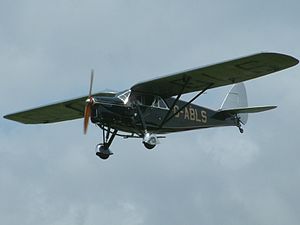De Havilland DH.80 Puss Moth
| De Havilland DH.80 Puss Moth | |
|---|---|

|
|
| Type: | Touring plane |
| Design country: | |
| Manufacturer: | |
| First flight: |
September 9, 1929 |
| Production time: |
1930 to 1933 |
| Number of pieces: |
284 |
The De Havilland DH.80 Puss Moth was a high- wing single-engine touring aircraft made by the British manufacturer de Havilland Aircraft Company . The model, built from 1929 to 1933, offered space for two to three people. With a speed of nearly 200 km / h it was one of the fastest private aircraft of its time.
history
De Havilland developed the DH.80 for British private aviation. The prototype, which was still largely made of wood, made its maiden flight on September 9, 1929 . The newly developed de Havilland Gipsy III in-line engine served as the drive . In the closed cockpit , two successively arranged were seats .
After completing the test flights, de Havilland opted for a hull made of fabric-covered steel tubes. This revised version was named DH.80A Puss Moth . The first production model made its maiden flight in March 1930, only to be brought to Australia and New Zealand for advertising purposes .
By the end of production in March 1933, 284 copies had been built, including 25 models by the de Havilland Canada subsidiary . The DH.80A were mainly used for private aviation. Some were used for airmail delivery. Most planes received the improved Gispy Major engine. In the passenger version, in addition to the pilot, two passengers could be accommodated in staggered seats.
Several flight records were set with the DH.80A. Between July and August 1931, a solo flight from England to Tokyo took only eight days. In the same year, a pilot only needed 22 hours to cross the South Atlantic in a west-east direction. It was only the second solo flight across the Atlantic. James Allan Mollison made the first transatlantic solo flight from east to west with a Puss Moth in August 1932 from Portmarnock Strand in Ireland to Pennfield Ridge in New Brunswick .
In 1933 the Puss Moth was replaced by the Leopard Moth , which, thanks to its plywood construction, could be manufactured more cheaply.
Military users
-
 German Empire : some
German Empire : some -
 Kingdom of Iraq
Kingdom of Iraq
-
 Canada
Canada
- Spanish Republican Air Force
- United States Navy : 1 copy for use at the US Embassy in London
Technical specifications
| Parameter | Data |
|---|---|
| crew | 1 |
| Passengers | 1-2 |
| length | 7.60 m |
| span | 11.20 m |
| height | 2.10 m |
| Wing area | 20.6 m² |
| Empty weight | 575 kg |
| Takeoff weight | 932 kg |
| Top speed | 196 km / h |
| Service ceiling | 3,330 m |
| Range | 483 km |
| Engines | a de Havilland Gipsy III in-line engine with 97 kW |
